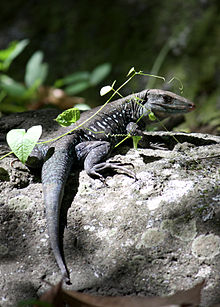
Griswold's ameiva is a species of lizard in the family Teiidae. The species is endemic to Antigua and Barbuda, where it is found on both islands. It is also known as the Antiguan ameiva or the Antiguan ground lizard.
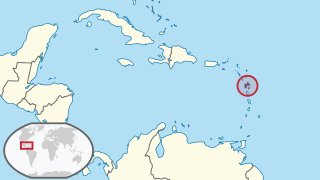
The Guadeloupe ameiva was a species of Teiidae lizards that was endemic to Guadeloupe. It is known from specimens collected by early European explorers. The fossil record shows that it once ranged across Guadeloupe, La Désirade, Marie-Galante, and Îles des Saintes, but in most recent times it was restricted to Grand Ilet, just offshore of Petit-Bourg. It was last recorded in 1914. Its extinction likely occurred when this area was decimated by a hurricane in 1928. The Guadeloupe ameiva was reported as a ground-dwelling lizard. It fed on plants and carrion.
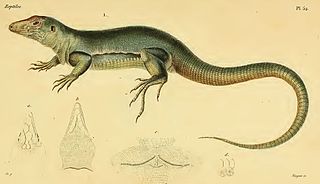
The Martinique giant ameiva was a species of lizard in the family Teiidae. It is believed to have been endemic to Martinique, though at least one scholar disputes this, instead placing it on Les Iles de la Petite Terre within the Guadeloupean archipelago. It is known only from museum specimens collected by early European explorers. Its extinction may have been caused by a hurricane, or through the introduction of predatory species to the island.
Pholidoscelis maynardi, commonly known as the Great Inagua ameiva, Inagua ameiva, or Inagua blue-tailed lizard, is species of lizard, a member of the family Teiidae. The species is endemic to the Bahamas. Three subspecies have been described.
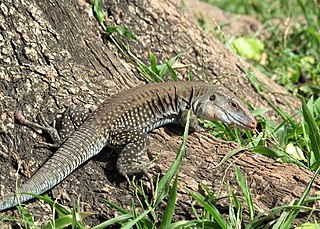
The common Puerto Rican ameiva or Puerto Rican ground lizard is a species of lizard in the whiptail family.

Anolis oculatus, the Dominica anole, Dominican anole, eyed anole or zandoli, is a species of anole lizard. It is endemic to the Caribbean island of Dominica, where it is found in most environments. The species is found in a diverse range of color forms, which one herpetologist once classified as four subspecies, which most other scientists did not recognise because the forms gradually inter-grade with one another. Two later researchers have instead promoted the "ecotypes" concept, hypothesizing the color forms are maintained by the ecological conditions of the surrounding environment, despite being genetically indistinguishable. The morphology of some traits is subject to clinal variation, gradually changing from one side of the island to the other, or from sea level to the hilltops. The ground color ranges from pale tan or yellow to deep green or brown. It also has patterned markings that range from light-colored speckling to complex marbled patterns, and some populations also have large black-ringed "eye" spots on their flanks.
The Sombrero ameiva is a lizard species in the genus Ameiva. It is endemic to Sombrero, a small, uninhabited island in the Lesser Antilles under the jurisdiction of Anguilla.
Censky's ameiva, also known as the Little Scrub Island ground lizard, is a species of lizard in the family Teiidae. It is indigenous to the Caribbean.

Pholidoscelis plei, known commonly as the Anguilla Bank ameiva or the Caribbean ameiva, is a species of lizard in the family Teiidae. The species is found on the Caribbean islands of Anguilla, Saint Martin, and Saint Barthélemy in the Lesser Antilles. Its coloration and markings vary between each island population. Two subspecies are recognized as being valid, including the nominotypical subspecies.

The St. Christopher ameiva is a lizard species in the genus Pholidoscelis. It is found on the Caribbean island of Sint Eustatius, and on Saint Kitts and Nevis, where it is more scarce.
The Montserrat ameiva is a lizard species in the genus Pholidoscelis. It is found on the Caribbean island of Montserrat in the Lesser Antilles.
Vincent's least gecko is a species of lizard in the family Sphaerodactylidae. The species is endemic to the Caribbean.

Julia's ground snake is a species of snake in the family Colubridae. The species is found in the Caribbean, on the Lesser Antilles islands of Dominica and Guadeloupe.

Dominica Botanic Gardens is located on the Caribbean island-nation of Dominica, in the capital of Roseau. Once known as one of the finest botanical gardens in the region, it was severely damaged by Hurricane David in 1979. Following restoration efforts, it remains a focus of cultural life in Roseau, and a center of conservation research on Dominica.
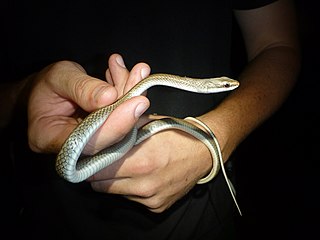
Barbour's tropical racer is a species of snake in the family Colubridae. The species is endemic to the Caribbean.

Pholidoscelis wetmorei is a species of lizard in the family Teiidae (whiptails). The species is endemic to Puerto Rico. Its common names include the Puerto Rican blue-tailed ameiva, Wetmore's ameiva, and blue-tailed ground lizard.

Pholidoscelis is a genus of lizards that belongs to the family Teiidae. All species are endemic to the West Indies.
Anolis bremeri, also known commonly as the Cuban variegated anole and the Herradura anole, is a species of lizard in the family Dactyloidae. The species is endemic to Cuba. Two subspecies are recognized.
